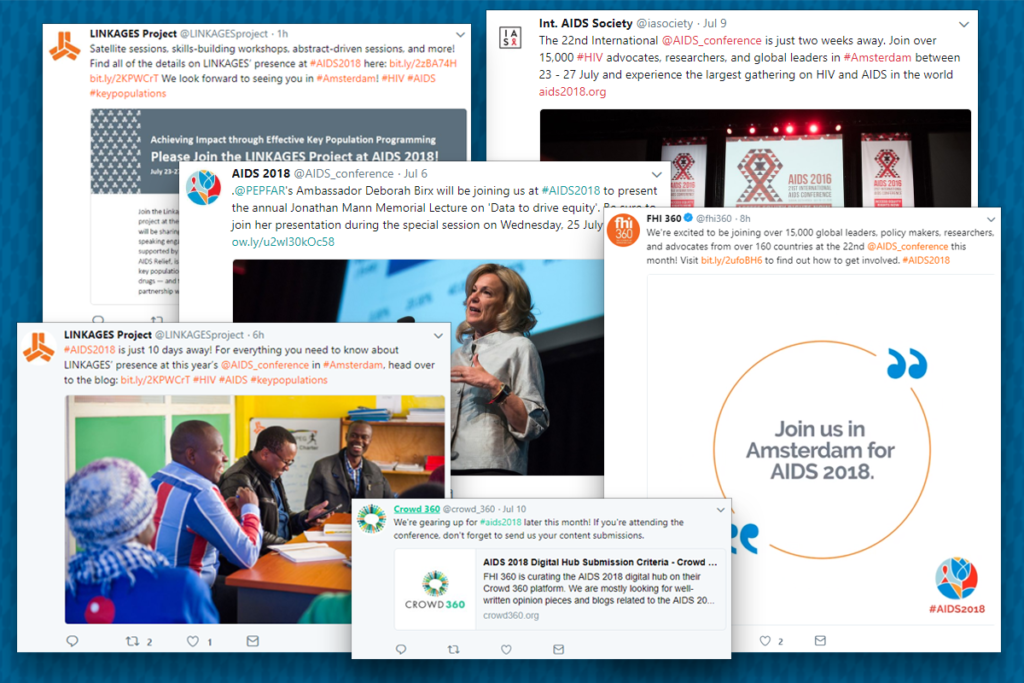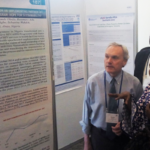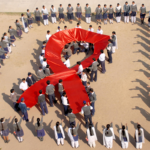The 22nd International AIDS Conference (AIDS 2018) is being held in Amsterdam next week. More than 20,000 people from all corners of the world will convene to share information on how best to end the HIV/AIDS epidemic. Science is at the core of the meeting, producing new treatments, prevention methods and diagnostics, and also, through implementation science, improved programs that deliver greater impact more efficiently.
The “Breaking Barriers, Building Bridges” conference theme aims to draw attention to “the need of rights-based approaches to more effectively reach key and priority populations.” This theme builds on the overarching global framework to end the AIDS epidemic: the 90-90-90 targets by 2020 for HIV-infected people knowing their status, receiving sustained antiretroviral therapy (ART), and achieving viral suppression. We’d like to draw your attention to some particularly important presentations from FHI 360 scientists that contribute to these goals.
First, to address the critical need to reach HIV-infected persons with efficient HIV testing approaches, Auxilia Muchedzi and colleagues are presenting an abstract on “Improving technical efficiencies: reaching the first 90 through community index HIV sexual network testing in Zimbabwe.” This program was designed to address one of the most challenging aspects of epidemic control, reaching young HIV-infected people, especially young men. In this program, when a person was identified as HIV-positive, a community health team obtained consent from this individual to reach out to those in the household and other sexual contacts for HIV testing. The program yielded impressive results: in one year, starting with 14,818 HIV-positive index cases, 22,147 people were HIV tested and 38% were found to be HIV-positive, and 69% of them were linked to care and ART. Overall, 11,754 men were HIV tested, including 72% aged 25-49 years. This program demonstrated that a community-based team could use index HIV sexual network testing to reach groups of HIV-infected people that otherwise would not have been tested.
To address the second 90 (receiving ART) in Botswana, Boitumelo Segwabanyane, et al. are presenting a poster on “Index partner testing in the community key to identifying new people living with HIV (PLHIV).” The authors trained lay community health workers to support health facilities to trace HIV-positive persons who did not link to care and ART, or had defaulted from ART. Of 584 persons traced, the health workers were able to link 54% to ART, in addition to 25% found to already be in ART. Community patient tracking can be a cost-effective way to link and retain HIV-infected persons in ART programs.
As we look to the day when HIV will be eliminated, the experience in Cambodia is very instructive. Seng Sopheap, on behalf of Dr. Ly Penh Sun, Director of the National Center for HIV/AIDS, Dermatology, and STI (NCHADS), is presenting an abstract on the use of boosted-integrated active HIV case management (B-IACM) approach to move beyond 90-90-90 to HIV elimination. The general adult HIV prevalence in Cambodia in 2016 was 0.6%, down from 1.7% in 1998. This success was due to strong prevention programs, expansion of HIV testing and scale-up of ART. In 2016, it was estimated that 83% of 70,498 people living with HIV (PLWH) knew their status and 97% were on ART. The focus now is on finding the roughly 12,000 PLWH who do not know their status. The B-IACM strategy uses a multi-pronged, coordinated approach to find HIV-infected persons and start them on ART. By 2017, it was estimated that 90% of PLWH in Cambodia knew their status and that, among newly detected HIV-positive persons, ART was initiated for 96% and 97% achieved viral suppression. Bravo to Cambodia for leading the way to HIV elimination.
Effective HIV prevention, care and treatment for key populations is critical for epidemic control. Gift Kamanga and colleagues, from the LINKAGES project in Malawi are presenting on “Delivering a high-quality comprehensive package of HIV prevention, care, and treatment for key populations is possible.” Using an approach integrated with key populations, civil society organizations, and government services, the authors reached 9,601 female sex workers with services during a 9-month period: 38% were known to be HIV-positive; of the 5,136 eligible for HIV testing, 40% were found to be HIV-positive, and 90% were started on ART. Of 2,696 men who have sex with men (MSM) reached, 2,561 (95%) were HIV tested and 188 (7%) were found to be HIV-positive; 61% were started on ART. The program has identified 239 transgender women and now works to scale-up services for them. This program can serve as a model for integrated key population services.
In the Asian context, the USAID/PEPFAR LINKAGES project is exploring innovative key population prevention, care and treatment services. LINKAGES partner Pich Seekaew and colleagues at the Thai Red Cross AIDS Research Center in Bangkok are conducting implementation science research on same-day initiation of ART at an HIV/STI testing center. The authors found that 87% of 1,062 newly diagnosed or re-engaged HIV-positive persons were eligible for same-day ART, 90% accepted the service, and of them, 82% were clinically eligible and started same-day ART. This innovative program is providing important data on the feasibility and safety of same-day ART programs that will allow for scale-up.
The team at the Thai Red Cross Center and Tangerine Community Health Center in Bangkok, led by Rena Janamnuaysook, are presenting an abstract on the use of female hormones, referred to as gender affirmative hormone treatment (GAHT) for transgender women as part of a comprehensive service package that improves HIV prevention uptake, including pre-exposure prophylaxis (PrEP). Of 972 transgender women who attended the clinic between November 2015 through December 2017, GAHT was used by 34%. Of the 91% of transgender women HIV tested, 12% were seropositive and 80% started ART. Overall, transgender women who used GAHT were more likely to return for clinic visits, have repeat HIV and syphilis testing, and start PrEP. It appears that the integration of GAHT as part of services for transgender women improves HIV prevention.
FHI 360 science is well represented at AIDS 2018 – our scientists are presenting dozens of other abstracts and participating in multiple satellite sessions, workshops and panels. Staff from the LINKAGES project have 24 speaking engagements and almost 50 poster presentations based on staff efforts in 30 countries on HIV prevention, care and treatment programs for key populations. You can view many other FHI 360 activities via the filtered conference program, like the U.S. National Institute of Health’s HIV Prevention Trials Network and the FHI 360-led OPTIONS project pre-conference session “Insight to Impact – Driving Demand Creation for HIV Prevention.”
This brief summary gives you an idea of the breath of science FHI 360 is presenting at AIDS 2018. In the coming years, we will continue to explore cost-efficient interventions that will contribute to PEPFAR programs achieving HIV epidemic control and allowing for a transition of sustainable programs to host-country ownership.



